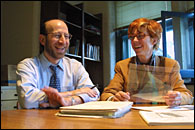Working for a community's good
Finding a balance between research demands and the needs of a community is key to successful collaboration for two McGill professors who work in one Montreal's most complex and densely populated neighbourhoods.
 Professors Raphaël Fischler and Renée Sieber
Professors Raphaël Fischler and Renée SieberPHOTO: Owen Egan |
|
"One of the critical things you have to learn is that you cannot abandon their agenda just because you have a grant, or you have to have a paper published," says McGill's Renée Sieber. "Community groups are frequently burned by students and academics."
Sieber, a professor with a joint appointment in Environmental Studies and Geography, is sitting behind an impressive two-inch-high pile of maps students have researched and created of and for Montreal's Parc Extension residents. They show everything from the number of garbage bags produced per person per week to how many parents are within 15 minutes' walking distance of a proposed new daycare.
Sieber and Raphaël Fischler, of the School of Urban Planning, have spent two years shoehorning the needs of this tiny but incredibly dense Montreal neighbourhood of tens of thousands into semester-sized bits, made for the schedules of students. In the end, they have helped create a new master plan for Parc Ex, to be used by the residents to argue for more services from the city.
The biggest stories are told by the smallest details. Two hundred surveys asked such mundane questions as how often the landlord has repainted the terrace, and who has a stove and fridge.
"We think there are keystone indicators of health, and they are set by the community," says Sieber. "The ability for a pedestrian to cross Jean Talon is indicative of the health of that community."
The project, funded by a $60,000 grant (for administrative costs) from the provincial ministry of education's Fonds de service aux collectivités program, was to help a community build such a set of indicators.
Calculating indicators can be a bit tedious, although it's a hot academic topic. "It may not have received the time and attention that we would have liked. People in Parc Ex were interested in community indicators [but did not drop everything to learn the details] as much as expected.
"But this is a wonderful case study of helping people," says Fischler. "We try to fill a community need that's at the same time a pedagogical need. It's a win-win situation."
So-called "town and gown" issues are complex.
Fischler says McGill began to institutionalize working with neighbourhoods some 10 years ago when a student residence was built in an old factory. Poorer neighbours wanted that factory retooled for jobs, not as affordable housing for strangers.
McGill offered something else that was within the University's power: a few years of free brains and labour on neighbourhood projects, through its academics and students. And that started what is now becoming a tradition.
The School of Urban Studies, with its focus on studio courses, allows for flexibility. The bulk of work is done in cooperation with municipalities, or heritage and community groups. (Businesses, unless they're block-long collections of mom-and-pop stores, are expected to pay for services.)
Both of the professors have a history of community activism and involvement. "We both are interested in similar questions," says Fischler. "She does e-commerce and I do history, but in common we are interested in working at the neighbourhood level.
"It's helping communities develop a capacity for analysis."
In this case, the expertise has been given to the umbrella community group RAMPE, the Regroupement en amènagement de Parc Extension. Parc Ex has the city's highest population density, squeezing more than 30,000 people into 1.45 square kilometres. Eighty-eight percent of its residents (who almost all rent), are neither franco- nor anglophone by birth. And the large-scale focus on the whole community allows for a more thoughtful and complete analysis.
Sieber specializes in GIS, or geographic information science. "It's high tech, it's spatial databases. This is an application of technology to the marginalized, to low-income communities, that's seemingly out of reach to the people who have no voice. I'm interested in breaking the cliché, that there's no way in hell they can use this stuff, that it's too hard.
"You can use this to find out a particular landlord who seems to be doing the same [bad] thing, to create a landlord hit list. The practical implementation of that is not in the least lofty."
Getting the raw data, though, takes shoe leather. Sieber says even Statistics Canada is obliged to sell its numbers. That's where the students come in.
Which vacant lots would be perfect for affordable housing? Which lots are contaminated by heavy metals from a previous industrial tenant?
Sieber's five-year-old Environ-mental Studies department is a university toddler, still learning. She discovered the costs of soil sampling analysis are prohibitive. "We're still looking at how easy it would it be to do primary data collection. We could only afford to test for certain things."
And both professors also note that their ideas of good public participation cannot be dropped into new communities. Two students worked on organizing public meetings -- but it's very hard to attract some immigrants to such events.
"It's not just language," says Sieber. "They may have no history of public participation in their culture.
"You have to be vigilant because the infrastructure has been stripped out of it -- most are just making enough to get by, they don't have a lot of time to think about the future."
City bureaucracies have their own master plans. But of course, only residents can truly explain what they need down the street. Says Fischler: "Cities have scarce resources, very often with cities it's top down."
This project's new master plan has helped even the odds, Fischler says. "It gives them a united voice. They're heard better by city because they've done their homework, have data to back up its claims. And in the process it brings together, creates synergy between people."

